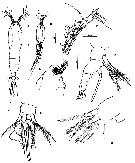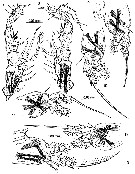|
|
 |
|
Monstrilloida ( Order ) |
|
|
|
Monstrillidae ( Family ) |
|
|
|
Cymbasoma ( Genus ) |
|
|
| |
Cymbasoma quintanarooense (Suarez Morales, 1994) (F,M) | |
| | | | | | | Syn.: | Thaumaleus quintanarooensis Suarez Morales, 1994 (p.381, Descr.F, figs.F); Grygier, 1995 a (p.73); Alvarez-Cadena & al., 1998 (tab.2) | | | | Ref.: | | | Suarez-Morales, 2000 a (p.204, Descr.M, figs.M); Lian & tan, 2019 (p.5: Rem., Table 2); Suarez-Morales & Escamilla, 2001 (p.1434, figs.F); Suarez-Morales, 2003 (p.71, figs.M, Rem.); Suarez-Morales & Morales-Ramirez, 2003 (p.210: Table 2) |  issued from : E. Suarez-Morales in Bull. Mar. Sc, 2003, 73 (1). [p.72, Figs.23-26]. Male (from Banco Chinchorro, Mexico): 23, habitus (dorsal); 24, idem (lateral; arrow shows subrtiangular ventral process on 5th pediger); 25, idem (ventral); 26, cephalic area (ventral; showing cuticular ornamentation). Nota: Cephalothorax representing about 44 % of body length. Oral papilla poorly developed, slightly protuberant, located 0.15 of way back along surface of cephalothorax. Eyes separated by a distance equal to less than 1/2 eye diameter. 1 pair of chitinized, whorl-like cuticular processes located ventrally between oral papilla and A1 bases. A1 5-segmented, representing about 73 % of the cephalothorax length; length ratio of antennular segments 18.7:25.1:13.1:21.8:21.3 = 100. P5 absent, but 5th pedigerous somite with reduced bud-like protuberance (arrowed in figs.24, 33). Genital complex represented by pair of genital lappets nearly cylindrical, moderately divergent. Urosome consisting of 4 somites (5th pedigerous somite, genital somite and 2 free abdominal somites (preanal and anal); about 19 % of total body length. Caudal rami with 4 setae (1 outer lateral, 2 terminal, 1 on inner margin).
|
 issued from : E. Suarez-Morales in Bull. Mar. Sc, 2003, 73 (1). [p.73, Figs.27-36]. Male: 27, right A1 (dorsal view); 28, left A1 (dorsal); 29, head (lateral); 30, P1; 31, P4; 32, genital complex (ventral); 35, caudal rami (dorsal); 36, lateral basipodal seta of P3.
|
 issued from : E. Suarez-Morales in Bull. Mar. Sc., 1994, 54 (2). [p.382, Fig.1] As Thaumaleus quintanarooensis. Female (from Bahia de Ascencion, Yucatan): A-B, habitus (dorsal and lateral, respectively); C, head (lateral); D, right A1; E, urosome (lateral); F, genital somite and 5th pedigerous somite (ventral); G, P1. Sclale bars in mm.
|
 issued from : E. Suarez-Morales in Bull. Mar. Sc., 1994, 54 (2). [p.383] As Thaumaleus quintanarooensis. Female: Formula of armement of swimming legs.
|
 issued from : E. Suarez-Morales & Escamilla in J. Nat. Hist., 2001, 35. [p.1435, Fig.1]. Female (from Laguna de Chelem, Yucatan): A, habitus (dorsal); B, idem (lateral); C, ovigerous spines (ventral); D, habitus (ventral); E, ovigerous spines (detail of distal section). Nota: Cephalothorax acconting for 59 % of total body length. Forehead slightly rounded in dorsal view. Anteriormost part of cephalothorax, just behind ocelli, with small dorsal patches of longitudinal striations arrow 1); transverse striations on ventral surface between oral papilla and bases of A1 (arrow 2); additional transverse striations in wide band across dorsal surface, occupying second quarter of cephalothorax length (arrow 3). Oral papilla lying midventrally 0.14 of length from anterior end of cephalothorax. Nauplius eye present, weakly developed, ocelli strongly pigmented withrounded shape in dorsal view. A1 4-segmented, representing 19.5 %of total body length;
|
 issued from : E. Suarez-Morales & Escamilla in J. Nat. Hist., 2001, 35. [p.1436, Fig.2]. Female: A, urosome whowing dorsal cuticular striations; B, right A1 (dorsal view); C, P2, showing armature of outer distal exopodal natatory seta; D, 5th pedigerous somite with P5 and anterior part of compound genital somite (lateral); E, idem (ventral). Nota: Distal segment of A1 with 2 spines terminal, forming pincer-like. P5 a single large lobe, slightly separated at base to its partner; lobe 2.5-3 times longer than thick, armed with 3 relatively long setae. Urosome consisting of 5th pedigerous somite, genital compound somite, and 1 free abdominal somite (anal somite); ratio of lengths of 5th pedigerous somite to ananl somite 34.7:47.8:19.1:17.4 = 100. Genital compound somite with small rounded ventral protuberanc on anterior part (visible in lateral view); genital compound bearing long, basally separated ovigerous spines (spines about 48.7 % of total body length. Caudal rami about as long as wide, moderately divergent, bearing 3 terminal setae subequal in length
|
 issued from : E. Suarez-Morales & Escamilla in J. Nat. Hist., 2001, 35. [p.1437] Female: Armature of swimming legs P1 to P4.
|
 Issued from : Suarez-Morales in Mitt. Mus. Nat.kd. Berl., Zool. Reihe, 2002, 78. [p.95, Table 1]. Comparison of main taxonomic features in species of Cymbasoma with a cephalothorax relative length equal or over 60%, females only: C. quintanarooense (Suarez-Morales, 1994). Mouth position way back anterior part of forehead in percentage of the cephalothorax length. Compare with C. bowmani, C. boxshalli, C. longispinosum, C. morii, C. nicolettae, C. striatus, C. thompsoni, C. tumorifrons, C. sp. (from Brazil), C. chelemense.
|
 Issued from : E. Suarez-Morales & A. Morales-Ramirez in Proc. Biol. Soc. Washington, 2003, 116 (1). [p.210, Table 2]. Selected taxonomic features in Cymbasoma quintanarooense. GDS = anterior half genital double-somite globose; IS = inner seta of P5 smallest; IS <50% = inner seta <50% as long as others; L = longest seta on P5; OP on CT = position of oral papilla on cephalothorax; AI/CT = relative length (as a percent) of A1 to cephalothorax; = relative length (as a percent) of position of oral papilla anteriorly on cephalothorax; T = transverse striations on ''neck'' area. Compare with species of Cymbasoma with uniramous P5 armed with 3 setae: C. consepcionae, C. reticulum, C. bowmani, C. boxshalli, C. bali, C. frondipes, C. striatum, C. claparedi, C. tumorifrons.
|
 Issued from : E. Suarez-Morales in Sarsia, 2000, 85. [p.205, Figs.1-6]. Male (from Mahahual reef zone, Yucatan): 1, habitus (dorsal); 2, habitus (lateral), showing a small, rounded cuticular process on the dorsal surface (arrowed) and two low protuberances, each bearing a large sensorial structure on the ventral part (arrowed); 3, forehead (dorsal); 4, urosome including genital somite, two free somites, and caudal rami (dorsal); 5, genital lappets (ventral); 6, same (lateral). Nota:- Cephalothorax representing slightly more than 45% of total body length. - Oral papilla located 27.2% of way back along ventral surface of cephalothorax. - As usual in Cymbasoma males, P5 absent. Pair of distally tapered, digitiform genital lappets present on genital somite. Lappets separated at base, moderately divergent, with irregular, coarse margins, tapering distally, tips moderately acute. Distal ends of lappets reach posterior margin of anal somite. - Urosome consisting of 4 somites: 5th pedigerous somite, genital somite, and 2 free somites; posterior one of the latter (anal somite) almost as long as genital somite, which is largest in urosome. Ratio of lengths of genital somite and following 2 free somites: 42.4 : 21.2 : 36.3 = 100. Caudal rami nearly as long as wide, terminal end as wide as proximal one, bearing 4 well developed terminal setae.
|
 Issued from : E. Suarez-Morales in Sarsia, 2000, 85. [p.207, Figs.7-13]. Male: 7, left A1 (dorsal); 8, right A1 (ventral); 9, P1; 10, right P2; 11, left P2; (same specimen, showing asymmetry on distal exopodal segment); 12, P3; 13, P4. Nota: A1 5-segmented, relatively long and slender, representing 0.39% of total body length, and ca. 85% as long as cephalothorax. Length ratio of antennular segments: 25 : 24.8 : 13.8 : 22.1 : 14.8 = 100.
|
 Issued from : E. Suarez-Morales in Sarsia, 2000, 85. [p.204]. Male: Armament formula of swimming legs P1 to P4.
| | | | | Compl. Ref.: | | | Suarez-Morales & Gasca, 1998 a (p.112); Suarez-Morales, 2001 b (p.26, Rem.); 2001 c (p.691); 2002 (p.95: tab.1) | | | | NZ: | 1 | | |
|
Distribution map of Cymbasoma quintanarooense by geographical zones
|
| | | | Loc: | | | Mexico (Yucatan) | | | | N: | 5 | | | | Lg.: | | | (285) M: 1,1-0,87; (733) F: 2,3-1,9; (862) F*: 1,95; (873) F: 1,7-2,2; (936) M*: 1,05-1,2; {F: 1,90-2,30; M: 0,87-1,20}.
* caudal rami excuded | | | | Rem.: | Sampling depth: 0-1.2 m.
After Suarez-Morales & Escamilla (2001, p1437) this species was originally assigned to the invalid (Grygier, 1994) genus Thaumaleus. Several features were not reported in the original description: the oral papilla was indicated by Suarez-Morales (1994) to be 0.28 of length posteriorly along the ventral surface of cephalothorax, while the correct figure is in fact 0.14 in both groups of specimens; Suarez-Morale (1994) described 2 low cephalic protuberances, one ventral between the oral papilla and the antennule bases, and the other on the dorsal surface of the head; the former was probably a misinterpretation of striations like those found in the same position in the Chelem specimen; the latter dorsal protuberance was not found in the Chelem specimen; the shape of the pigment cups in dorsal view is different in the specimens from the two localities (subtriangular in Bahia de la Ascension, rounded in Laguna de Chelem. The anal somite was depicted (in 1994) as being a large, partially divided somite; however , the anal somite is in fact short, and it is the genital somite that has a constriction and a dorsal band of striations suggesting a partial intersegmental division near the base of the ovigerous spines The antennular armature, in the work of 2001 is analysed for the first time according to the nomenclature of mostrilloid setation pattern proposed by Grygier & Ohtsuka (1995); neither the dichotomous branching of the three subterminal setae (b1-3 (in fig.3E), nor several elements of the armature of the distal antennular segments were mentioned in the previous description. There are differences between the type specimens and those recorded in the Laguna de Chelem. Most of them are related to the incomplete original description; therefore, these differences should be considrerd only as an extended morphological range for C. quintanarooense. Following the recently published key for the known males of Cymbasoma (Suarez-M0rales, 2000), the specimens from Banco Chinchorro do not correspond to C. quintanarooense, because of the non-bifid condition of the forehead shown by the Chinchorro specimens; there are some other differences between the Mahahual (Suarez-Morales, 2000) and the Chinchorro specimens: the relative lengths of the A1 (0.85 % vs. 76 % of the cephalothorax, respectively) and of the antennular segments; the anal somite of the Mahahual specimens show a serrated posterior margin, whereas it is nearly smooth in the Chinchorro material; the genital lappets are serrated along both sides in the Mahahual material but only on the outer margin in the Chinchorro specimens. Nevertheless, the structure of the genital complex still includes the most relevant characteristics for identification of the members of the genus. The most distinctive characters for this species, besides the lappets, are: the protuberance on the base of the genital lappets and the ventral process on the postgenital somite (see Suarez-Morales, 2003, figs.33, 24, and in Suarez-Morales, 2000, fig.6).
After Suarez-Morales (2017, p.1811) the male and female of C. quintanarooense were linked as being conspecific based on the saveral morphologic characters they share (see similar set of characters used to match the male and female of C. pseudibidentatum).
Cf Table 2 from Lian & Tan (2019) in C. cheni. | | | Last update : 17/09/2020 | |
|
|
 Any use of this site for a publication will be mentioned with the following reference : Any use of this site for a publication will be mentioned with the following reference :
Razouls C., Desreumaux N., Kouwenberg J. and de Bovée F., 2005-2025. - Biodiversity of Marine Planktonic Copepods (morphology, geographical distribution and biological data). Sorbonne University, CNRS. Available at http://copepodes.obs-banyuls.fr/en [Accessed November 17, 2025] © copyright 2005-2025 Sorbonne University, CNRS
|
|
 |
 |












